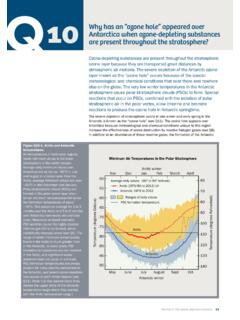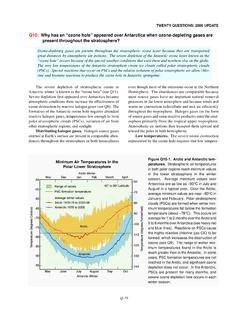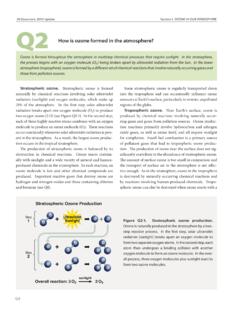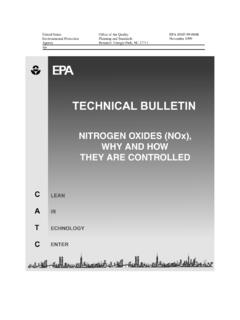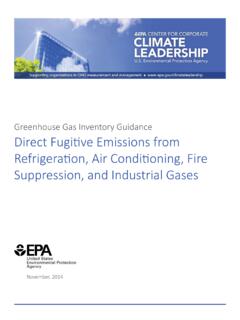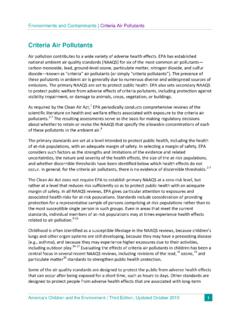Transcription of Q7: What emissions from human activities lead to ozone ...
1 TWENTY QUESTIONS: 2006 human -produced chlorine and brominegases. human activities cause the emission of halogensource gasesthat contain chlorine and bromine emissions into the atmosphere ultimately lead tostratospheric ozone depletion. The source gases that con-tain only carbon, chlorine, and fluorine are called chlo-rofluorocarbons, usually abbreviated as CFCs. CFCs,along with carbon tetrachloride (CCl4) and methyl chlo-roform (CH3 CCl3), historically have been the most impor-tant chlorine-containing gases that are emitted by humanactivities and destroy stratospheric ozone (see Figure Q7-1). These and other chlorine-containing gases have beenused in many applications, including refrigeration, air con-ditioning, foam blowing, aerosol propellants, and cleaningof metals and electronic components. These activitieshave typically caused the emission of halogen-containinggases to the category of halogen source gases containsbromine.
2 The most important of these are the halons and methyl bromide (CH3Br). Halons are halogenatedhydrocarbon gases originally developed to extinguishfires. Halons are widely used to protect large computers,military hardware, and commercial aircraft of these uses, halons are often directly releasedinto the atmosphere . Halon-1211 and halon-1301 are themost abundant halons emitted by human activities (seeFigure Q7-1). Methyl bromide, used primarily as an agri-cultural fumigant, is also a significant source of bromineto the emissions of the principal chlorine- andbromine-containing gases have increased substantiallysince the middle of the 20thcentury (see Q16). The resulthas been global ozone depletion, with the greatest lossesoccurring in polar regions (see Q11 to Q13).Otherhuman sources of chlorine and chlorine- and bromine-containing gases are releasedregularly in human activities .
3 Common examples are theuse of chlorine gases to disinfect swimming pools andwastewater, fossil fuel burning, and various industrialprocesses. These activities do not contribute significantlyto stratospheric amounts of chlorine and bromine becauseeither the global source is small or the emitted gases areshort-lived (very reactive or highly soluble) and, there-fore, are removed from the atmosphere before they reachthe stratosphere. Natural sources of chlorine and a few halogen source gases present in the stratospherethat have large natural sources. These include methylchloride (CH3Cl) and methyl bromide (CH3Br), both ofwhich are emitted by oceanic and terrestrial sources of these two gases contribute about 17%of the chlorine currently in the stratosphere and about 30%of the bromine (see Figure Q7-1). Very short-lived sourcegases containing bromine, such as bromoform (CHBr3),are also released to the atmosphere primarily from theoceans.
4 Only a small fraction of these emissions reachesthe stratosphere, because these gases are rapidly removedin the lower atmosphere . The contribution of these veryshort-lived gases to stratospheric bromine is estimated tobe about 24%, but this has a large con-tribution to stratospheric chlorine of short-lived chlori-nated gases from natural and human sources is muchsmaller (< 3%) and is included in the Other gases cat-egory in Figure Q7-1. Changes in the natural sources ofchlorine and bromine since the middle of the 20thcenturyare not the cause of observed ozone depletion. Lifetimes and emission, halogensource gases are either naturally removed from the atmos-phere or undergo chemical conversion. The time toremove or convert about 60% of a gas is often called itsatmospheric lifetime. Lifetimes vary from less than 1year to 100 years for the principal chlorine- and bromine-containing gases (see Table Q7-1).
5 Gases with the shortestlifetimes ( , the HCFCs, methyl bromide, methyl chlo-ride, and the very short-lived gases) are substantiallydestroyed in the troposphere, and therefore only a frac-tion of each emitted gas contributes to ozone depletion inthe stratosphere. The amount of a halogen source gas present in theatmosphere depends on the lifetime of the gas and theQ7:What emissions from human activities lead to ozone depletion?Certain industrial processes and consumer products result in the emission of halogen source gases to theatmosphere. These gases bring chlorine and bromine to the stratosphere, which cause depletion of the ozonelayer. For example, chlorofluorocarbons (CFCs), once used in almost all refrigeration and air conditioningsystems, eventually reach the stratosphere, where they are broken apart to release ozone -depleting chlorineatoms. Other examples of human -produced ozone -depleting gases are the halons, which are used in fireextinguishers and contain ozone -depleting bromine atoms.
6 The production and consumption of all principalhalogen source gases by human activities are regulated worldwide under the Montreal QUESTIONS: 2006 emitted to the atmosphere . emissions vary greatlyfor the principal source gases, as indicated in Table of most gases regulated by the MontrealProtocol have decreased since 1990, and emissions fromall regulated gases are expected to decrease in the comingdecades (see Q16). ozone Depletion halogen sourcegases in Figure Q7-1 are also known as ozone -depletingsubstances because they are converted in the stratosphereto reactive gases containing chlorine and bromine (seeQ8). Some of these reactive gases participate in reactionsthat destroy ozone (see Q9). ozone -depleting substancesare compared in their effectiveness to destroy strato-spheric ozone using the ozone Depletion Potential (ODP), as listed in Table Q7-1 (see Q18).
7 Agas with alarger ODP has a greater potential to destroy ozone overits lifetime in the atmosphere . The ODP is calculated ona per mass basis for each gas relative to CFC-11, whichhas an ODP defined to be 1. Halon-1211 and halon-1301have ODPs significantly larger than CFC-11 and mostother emitted gases, because bromine is much more effec-tive overall (about 60 times) on a per-atom basis than chlo-rine in chemical reactions that destroy ozone in the strato-sphere. The gases with small ODPvalues generally haveshort atmospheric lifetimes or fewer chlorine and bromineatoms. The production and consumption of all principalhalogen source gases by humans are regulated under theprovisions of the Montreal Protocol (see Q15).Fluorine and iodine. Fluorine and iodine are alsohalogen atoms. Many of the source gases in Figure Q7-1also contain fluorine atoms in addition to chlorine orbromine.
8 After the source gases undergo conversion inthe stratosphere (see Q6), the fluorine content of thesegases is left in chemical forms that do not cause ozonedepletion. Iodine is a component of several gases that arenaturally emitted from the oceans. Although iodine canFigure Q7-1. stratospheric source variety of gases transport chlorine and bromine into the gases, called halogen source gases, are emitted from natural sources and by human activities . These partitionedcolumns show how the principal chlorine and bromine source gases contribute to the respective total amounts of chlorineand bromine as measured in 2004. Note the large difference in the vertical scales: total chlorine in the stratosphere is160 times more abundant than total bromine. For chlorine, human activities account for most that reaches the strato-sphere. The CFCs are the most abundant of the chlorine-containing gases released in human activities .
9 Methyl chlorideis the most important natural source of chlorine. HCFCs, which are substitute gases for CFCs and also are regulatedunder the Montreal Protocol, are a small but growing fraction of chlorine-containing gases. The Other gases categoryincludes minor CFCs and short-lived gases. For bromine that reaches the stratosphere, halons and methyl bromide arethe largest sources. Both gases are released in human activities . Methyl bromide has an additional natural sources are a larger fraction of total bromine than of total chlorine. (The unit parts per trillion is used here as ameasure of the relative abundance of a gas in air: 1 part per trillion indicates the presence of one molecule of a gas pertrillion other air molecules.)Primary Sources of Chlorine and Bromine for the Stratosphere in 2004 TWENTY QUESTIONS: 2006 in ozone destruction reactions, these iodine-containing source gases generally have very short life-times and, as a result, most are removed in the tropospherebefore they reach the stratosphere.
10 Other gases that influence strato-spheric ozone abundances also have increased in thestratosphere as a result of human activities . Importantexamples are methane (CH4) and nitrous oxide (N2O),which react in the stratosphere to form water vapor andreactive hydrogen, and nitrogen oxides, reactive products also participate in the produc-tion and loss balance of stratospheric ozone (see Q2).The overall effect of increases in these other gases onozone is much smaller than that caused by increases inchlorine- and bromine-containing gases from humanactivities (see Q18).Heavier-Than-Air CFCsCFCs and other halogen source gases reach the stratosphere despite the fact that they are heavierthan air. All the principal source gases are emitted and accumulate in the lower atmosphere (troposphere).The distributions of gases in the troposphere and stratosphere are not controlled by the molecular weight ofthe gases because air is in continual motion in these regions as a result of winds and convection.
